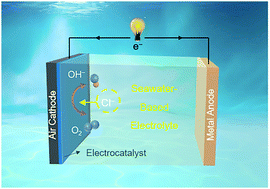Seawater electrolyte-based metal–air batteries: from strategies to applications
Abstract
Aqueous metal–air batteries are promising next-generation energy storage and supply technologies due to their advantages of high energy density and intrinsic safety. As an abundant natural resource, applying seawater-based electrolytes is proposed to have considerable economic and environmental benefits, and will significantly broaden the applications of metal–air batteries. However, the existence of complex components in seawater, in particular chloride ions, inevitably has a complex influence on air electrode processes, including the oxygen reduction and evolution reactions (ORR and OER), requiring the development of efficient chloride-resistant electrocatalysts. Meanwhile, a few seawater-based metal–air battery prototypes have shown great application potential but are still at an early stage of development. In this review, we first propose the concept of seawater-based metal–air batteries and comprehensively analyze the essential air electrode reactions in terms of thermodynamics and kinetics. Subsequently, rational design strategies for ORR and OER electrocatalysts suitable for use in chloride-containing and seawater-based electrolytes are comprehensively discussed. Moreover, the development history and potential applications of seawater-based metal–air batteries are demonstrated. Finally, a summary and outlook are provided for future innovations.



 Please wait while we load your content...
Please wait while we load your content...